If you’re looking to serve up a show-stopping, mouth-watering turkey this holiday season, look no further than my Fried Turkey Recipe! We’re talkin’ about a turkey so succulent and juicy on the inside, and perfectly crispy on the outside, it’ll make you wonder why you ever bothered with oven roasting. This bird is infused with a flavorful homemade injection and rubbed down in cajun seasoning, resulting in an out-of-this-world holiday experience!
This post may contain affiliate links. Read our disclosure policy.
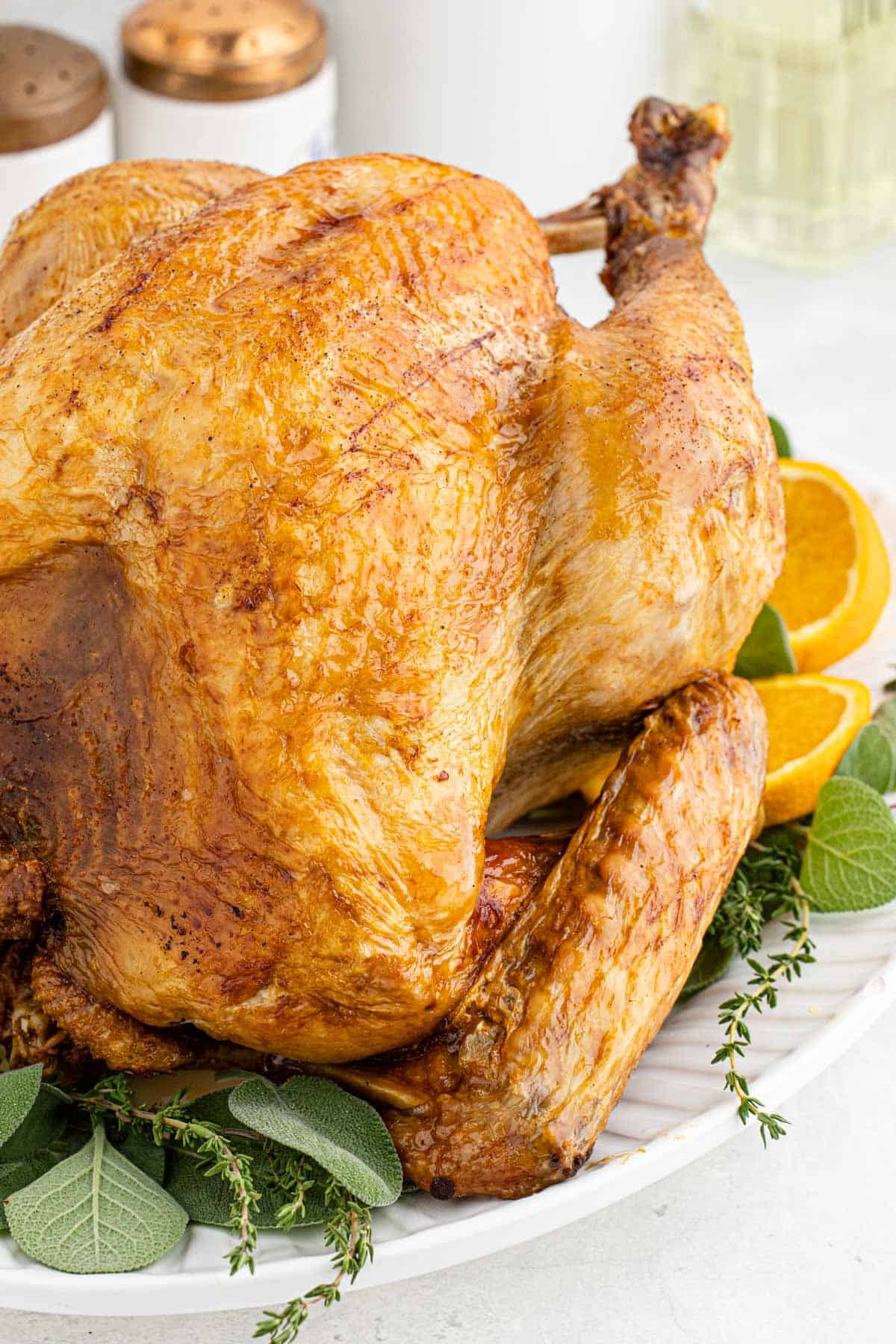
My daddy has been frying our Thanksgiving and Christmas turkey for the last ten years. Once we had the first taste, we never went back. Now, I know deep-frying can sound intimidating, but don’t you worry; this guide is as much a “How-To” as it is a recipe. I’m gonna take you step-by-step through the process, including a homemade turkey injection marinade that is so packed with flavor, it’ll make your taste buds dance!
The goodness doesn’t stop there. We’re not just frying any ol’ turkey; we’re elevating it with a blend of cajun spices that’ll bring a little Southern heat to your table. This recipe uses the king of oils—peanut oil—to get that crispy, golden exterior that’s signature to a well-fried turkey. So grab your apron and let’s get this party started, ’cause if you’ve been searchin’ for the ultimate fried turkey recipe, boo, you just hit the jackpot!
Whether you’re a fried turkey veteran or a newbie, this guide on how to fry turkey is fun, friendly and oh so delicious. Happy Thanksgiving y’all!
Warning: Frying a turkey is an extremely dangerous undertaking. Yes, there are precautions that can be taken to minimize the risk but there’s no way to heat up gallons of oil, dunk a turkey in it and be guaranteed that you won’t hurt yourself or others. Be sure to follow the safety guidelines provided below.
The Lowdown on This Fried Turkey

Cuisine Inspiration: Southern Creole
Primary Cooking Method: Deep-Fried
Dietary Info: Gluten-Free
Key Flavor: Juicy Turkey, with a Savory Cajun Kick
Skill Level: Intermediate
Juicy Injection Flavor
This turkey’s got a secret weapon: that rich, buttery injection marinade. With flavors like Worcestershire, a lil’ crab boil, and Cajun seasoning, you’re gonna get serious taste in every single bite.
Perfectly Crispy Skin
No rubbery skin here, y’all! Thanks to the deep-frying magic, you’ll end up with a turkey that’s got a crispy, crunchy skin on every side.
Quick Cookin’ Time
Unlike roasting, which takes forever, this fried turkey’s done in about an hour. So you’ll be carvin’ and eatin’ WAY sooner!
Safety Guidelines You Should Follow For Deep Frying Turkey
As mentioned above, frying a turkey is not something to be taken lightly. To ensure your own safety and the safety of others, it’s crucial to not only prepare but to do everything possible to prevent disaster.
Let’s kick things off with a few critical points:
- Children and pets should be nowhere near a deep-frying setup. There should be absolutely no chance they’ll get anywhere close to it.
- Before frying, read and follow the manufacturer’s instructions and warnings included with your deep fryer. Regardless of what’s written in this post, it’s more important to adhere to those rules rather than deviate.
- I don’t recommend the use of indoor fryers, it’s a bit too risky for my taste. But, if an indoor setup is your only option, make sure it is indeed an indoor setup. An outdoor setup will not suffice inside and vice versa.
- Keep a fire extinguisher on hand! Seriously y’all, you never know.
- Wear protective clothing. I highly recommend wearing long sleeves (maybe even layers), protective gloves and close-toed shoes. Oil splatter burns are not fun.
- Once in the fryer, do not leave it unattended! If you need relief from cold weather or have to take a bathroom break, find someone to take your place.
- Most importantly, DO NOT DRINK AND FRY. I know, it’s Thanksgiving and we all deserve to drink and enjoy, but I promise it’s not worth the potential ruin.
Okay, now that we’ve covered the serious stuff, let’s talk deep-frying!
Ingredients you’ll need to make Fried Turkey
Now, you don’t have to make the injection recipe, but I highly recommend it. Putting the flavor straight into the meat makes a world of difference. If this is your first Thanksgiving or Christmas dinner with new in-laws or guests and you really want to blow their minds – don’t skip the turkey injection!
For the Injection
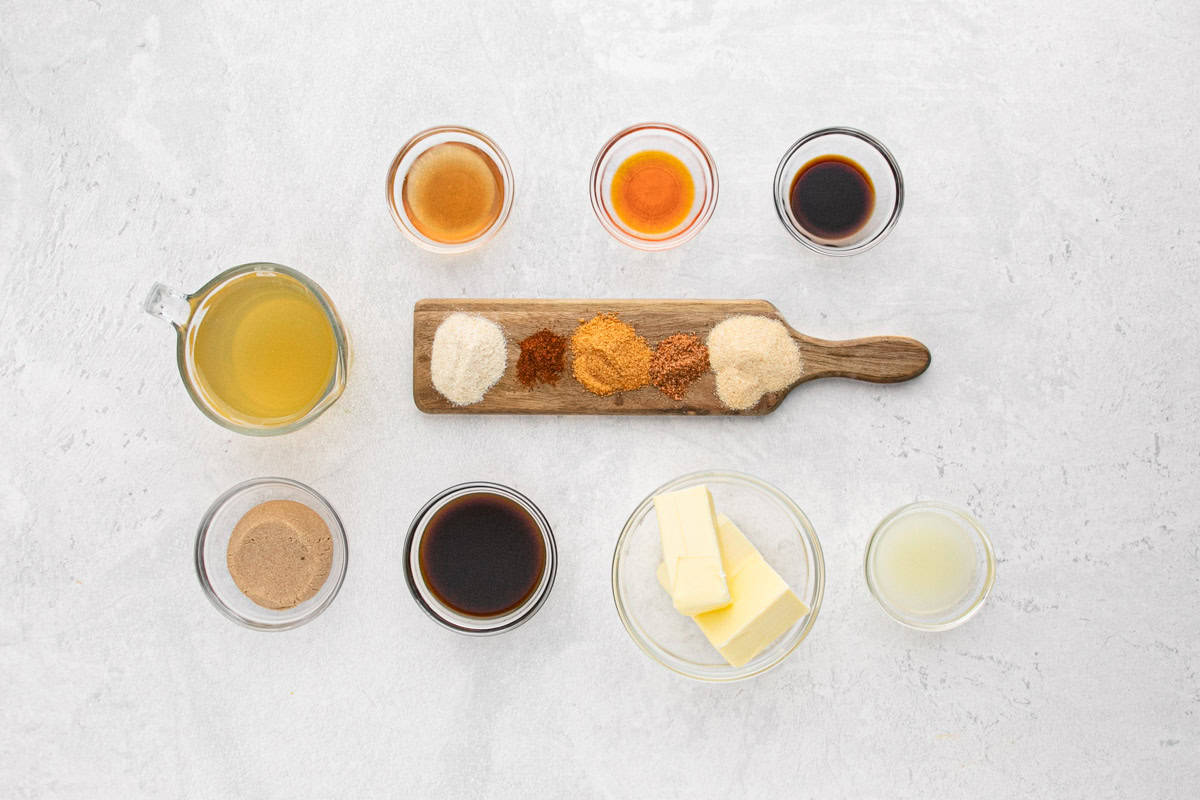
- Chicken stock: The base of your marinade, adding moisture and a hint of chicken flavor.
- Salted butter and oil: Because everything tastes better with butter! Melted and ready to give this fried turkey recipe some richness.
- Light brown sugar: Adds a nuanced sweetness that balances the savory and spicy elements.
- Worcestershire sauce: A complex flavor booster with a little tang, a little sweet, and a lot of savory.
- Apple cider vinegar: A splash of acidity to wake up those flavors.
- Onion Powder & Garlic Powder: These two are workin’ together to bring some serious flavor.
- Lemon juice: Brightens up the marinade.
- Concentrated liquid crab boil: A Southern staple that adds a unique spicy and aromatic complexity. It’s my secret ingredient, boos!
- Soy sauce: Adds a little salty depth.
- Seasoned Salt & Cajun Seasoning: These seasonings bring out ALL the flavors. Long live Cajun!
- Cayenne pepper: Just enough to add a dash of heat.
For the Turkey
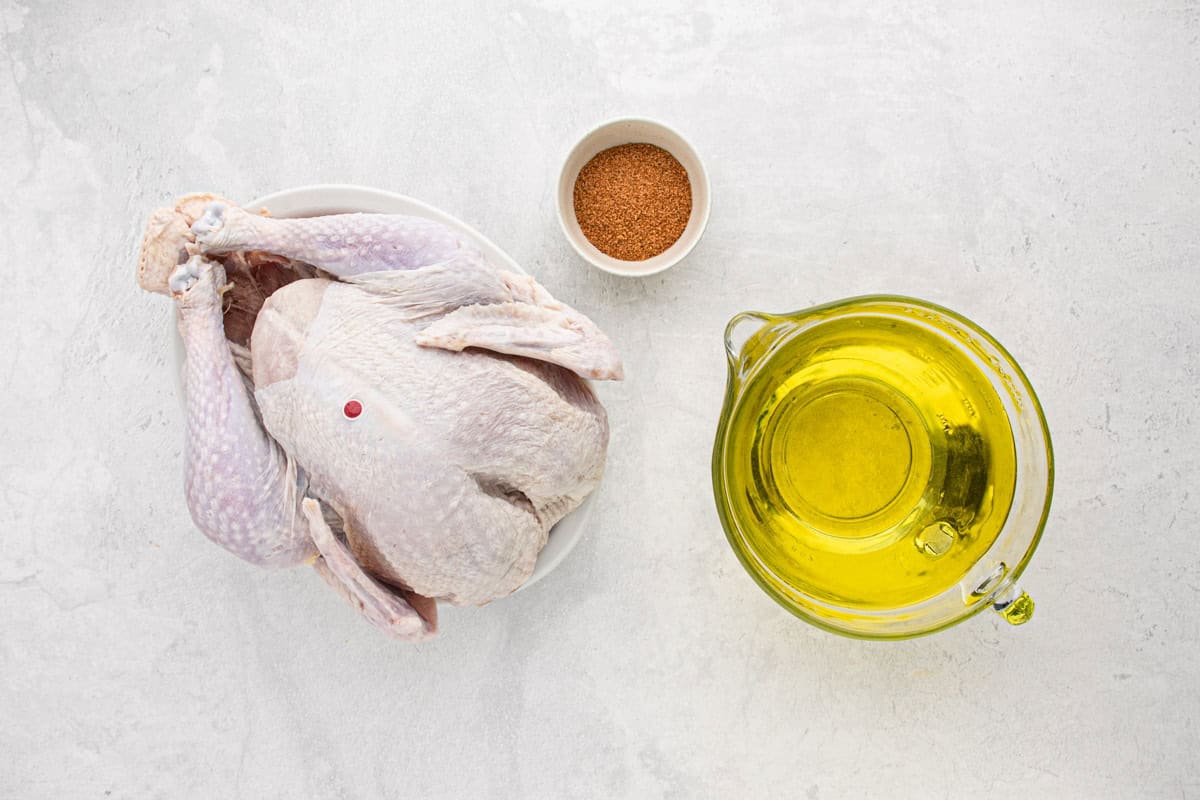
- Turkey: Go for high-quality, between 10 – 14 pounds and make sure it’s room temperature and fully thawed.
- Peanut oil: Essential for deep frying, it has a high smoke point and gives a nutty, rich flavor.
- More Cajun Seasoning (for the rub): Gives the turkey an extra layer of flavor. Use whatever blend you love best, whether it’s store-bought or homemade!
How to make Fried Turkey
Alright y’all, here’s where things get a bit serious. Before you begin prepping your turkey, you’ll need a foolproof frying-rig, which includes a burner and stand, a pot, a thermometer for the oil, and the hanger and lowering mechanism for the bird. You’ll also need a propane tank. You should NOT try to jury-rig your own setup.
The biggest mistakes people make when using this cooking method are: setting up the fryer in or near a home or something combustible, overfilling the pot with oil, and dropping the turkey too quickly, causing the hot oil to splash. Not fun.
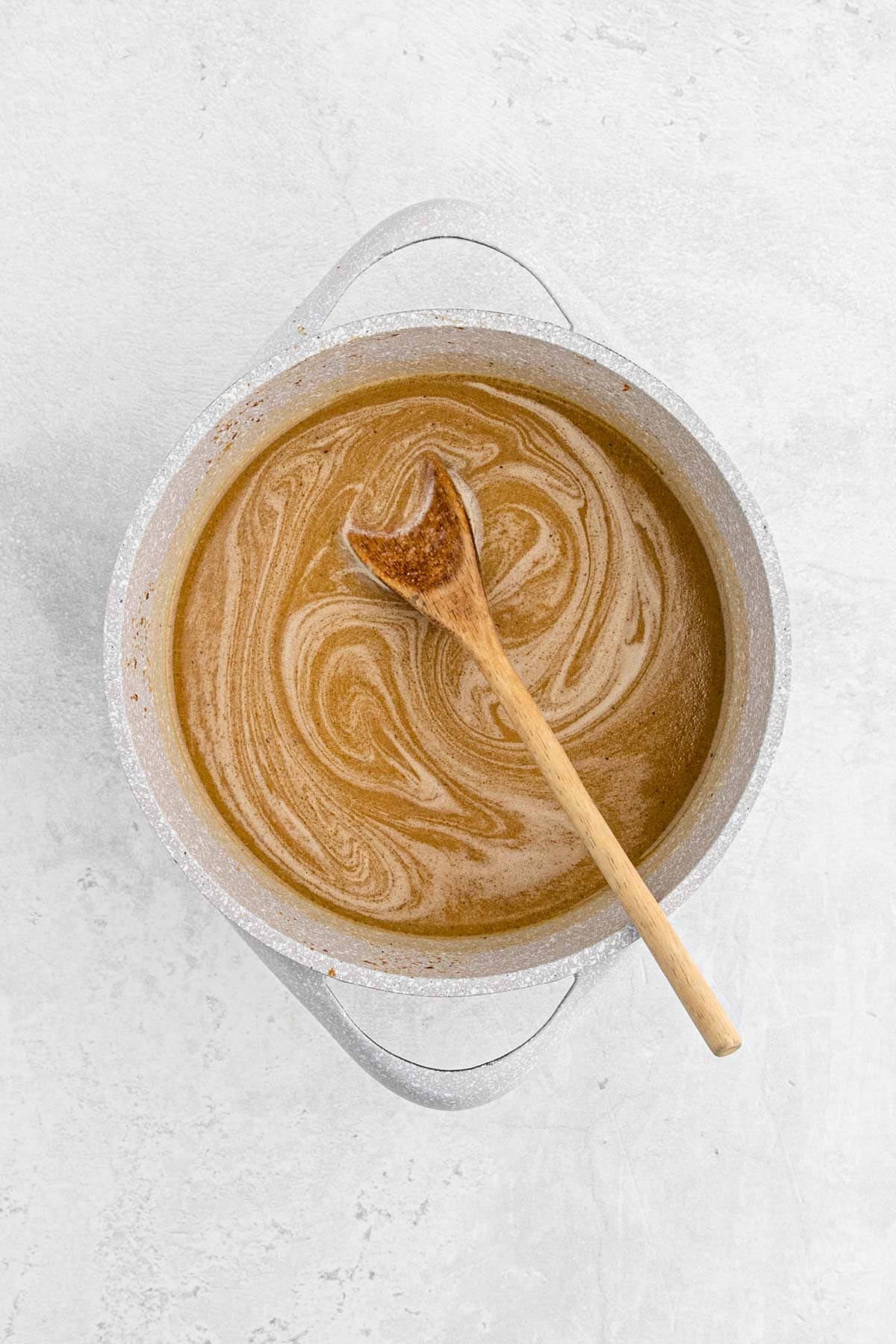
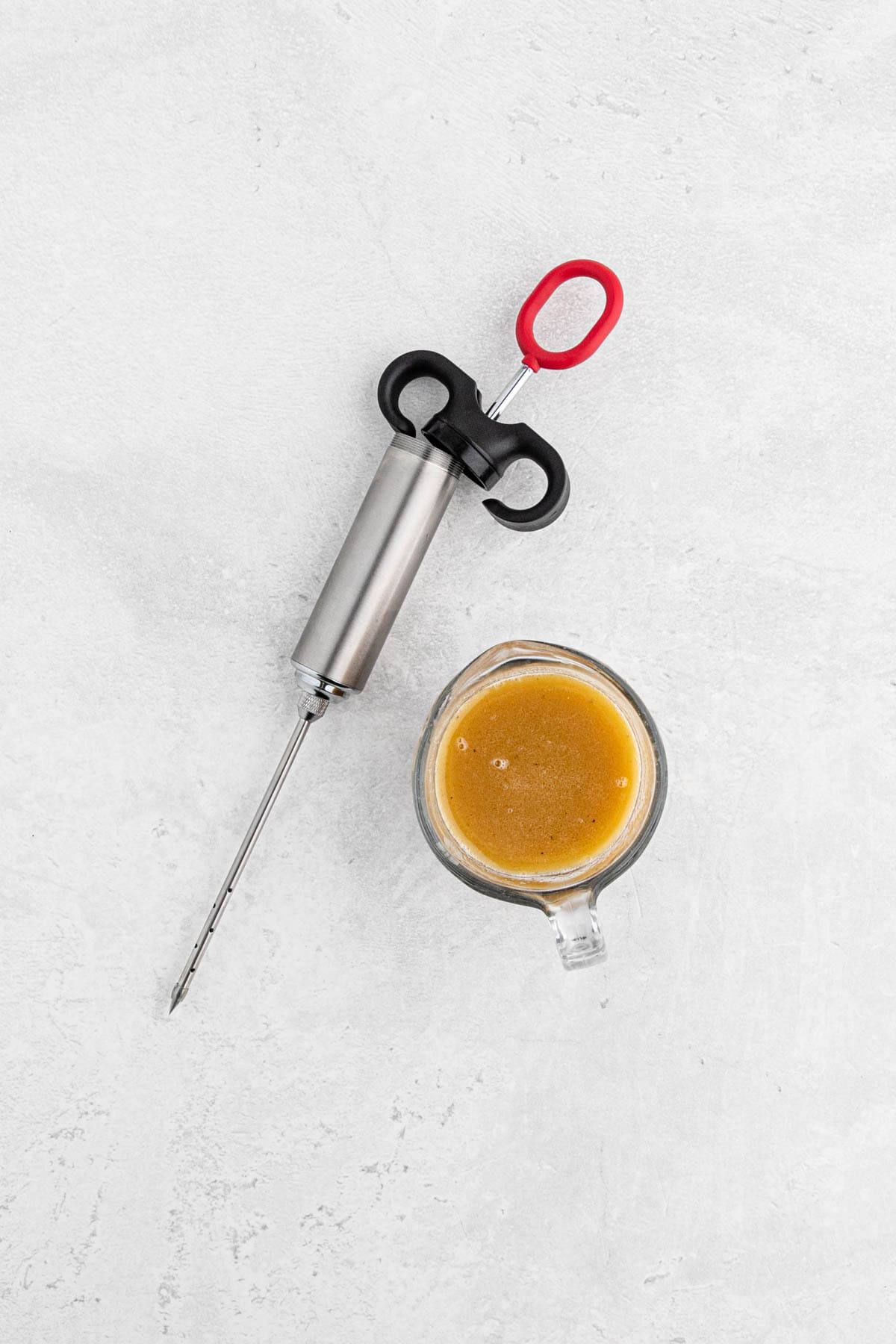
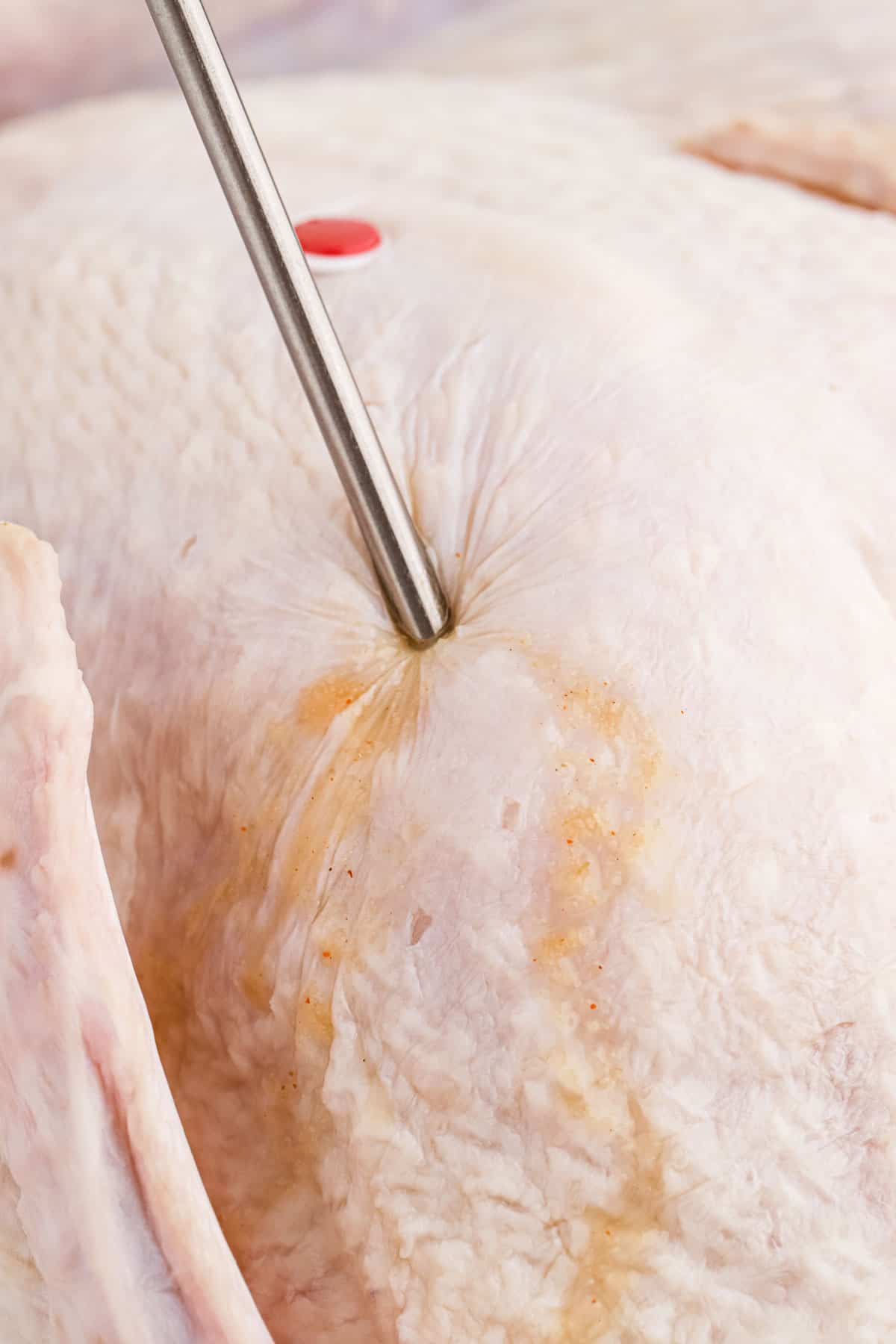
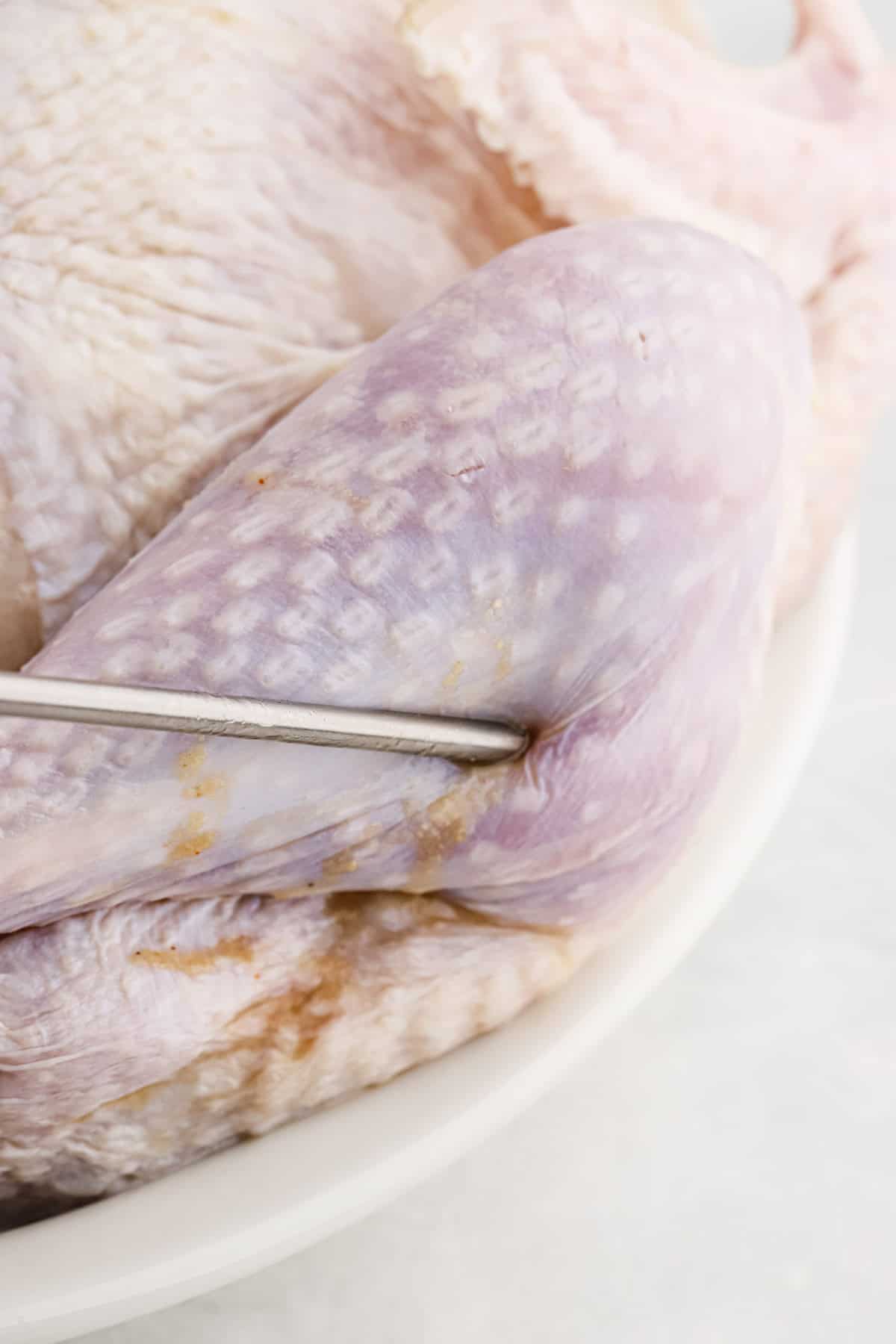
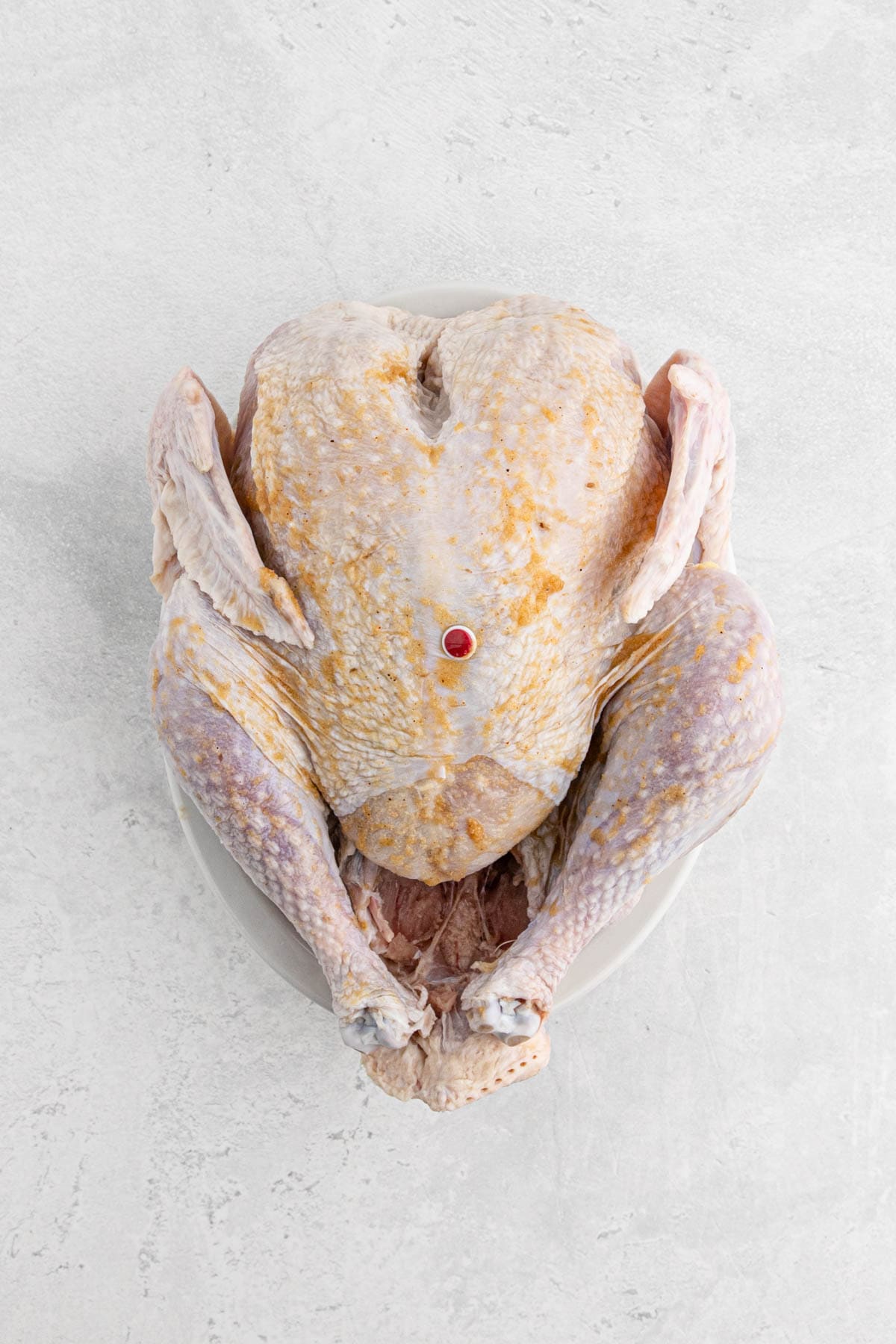
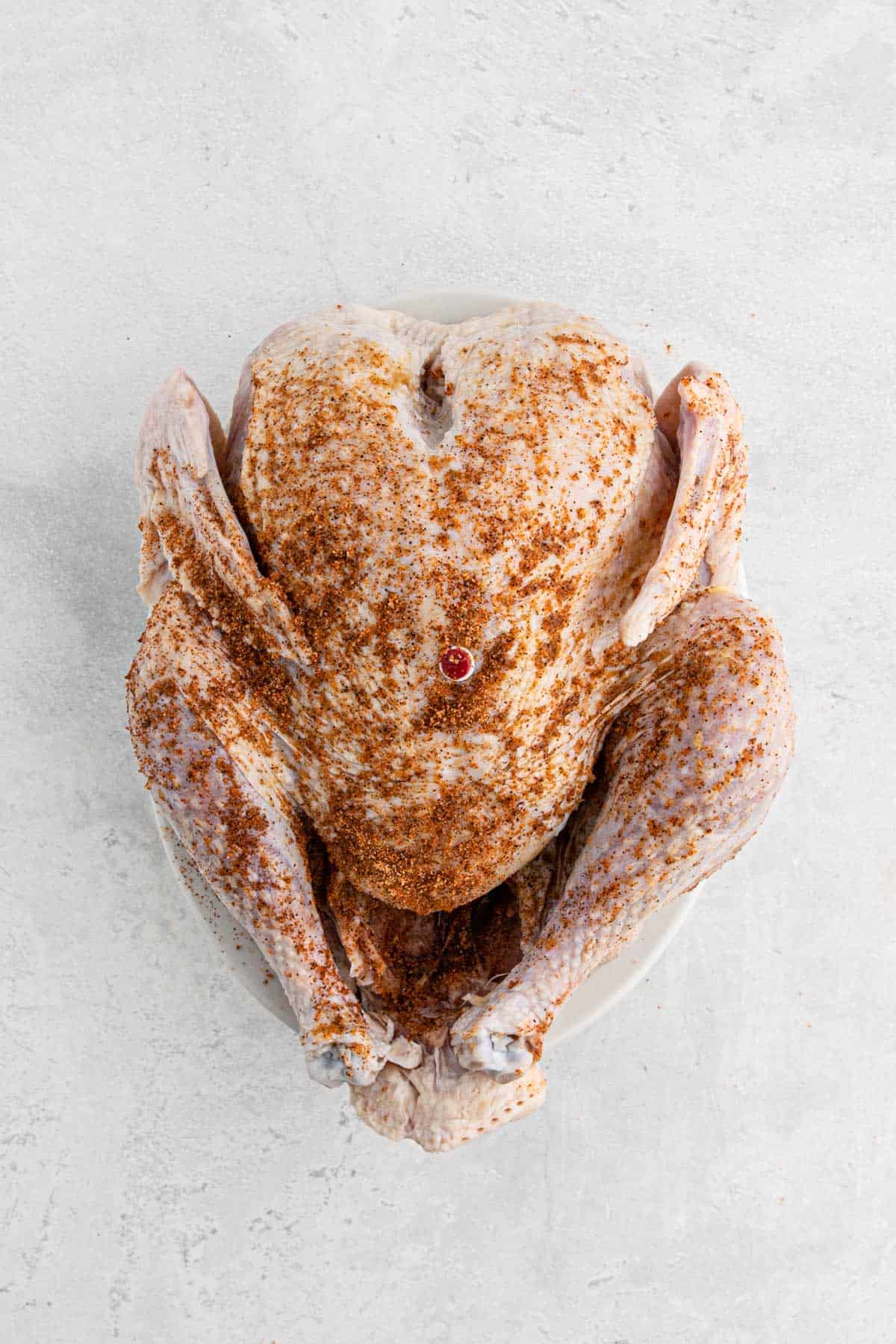
Want to Save This Recipe, Boo?
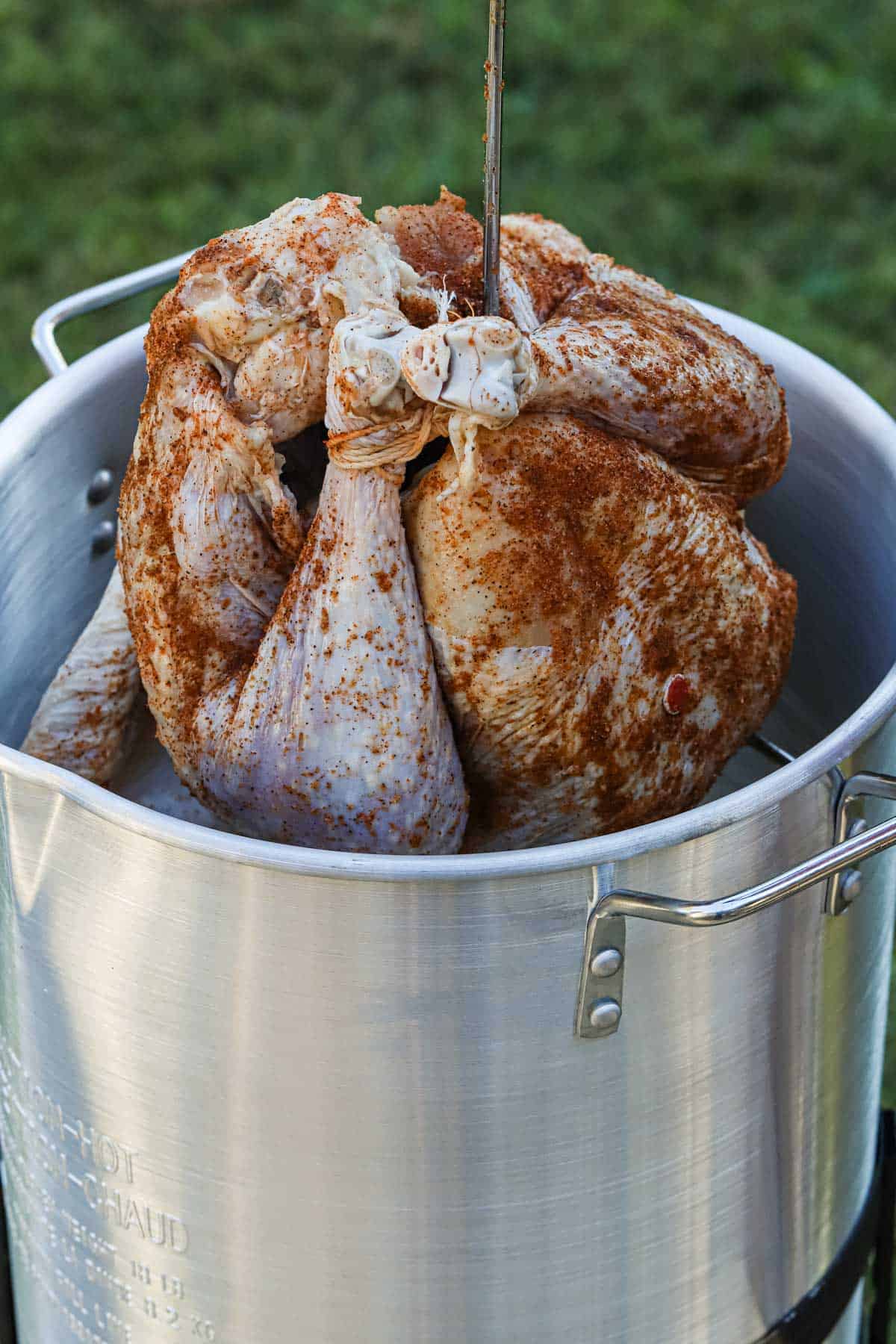
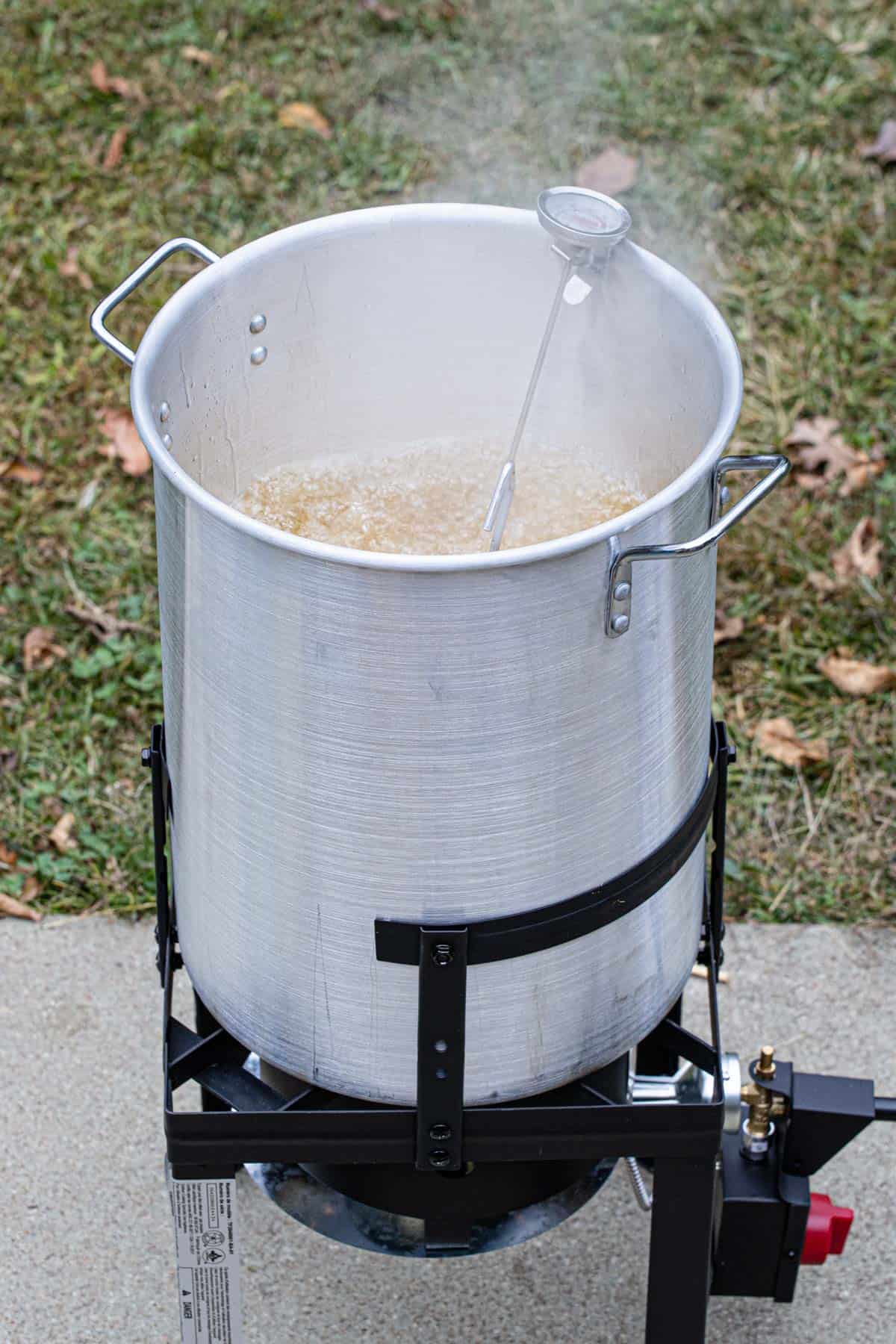
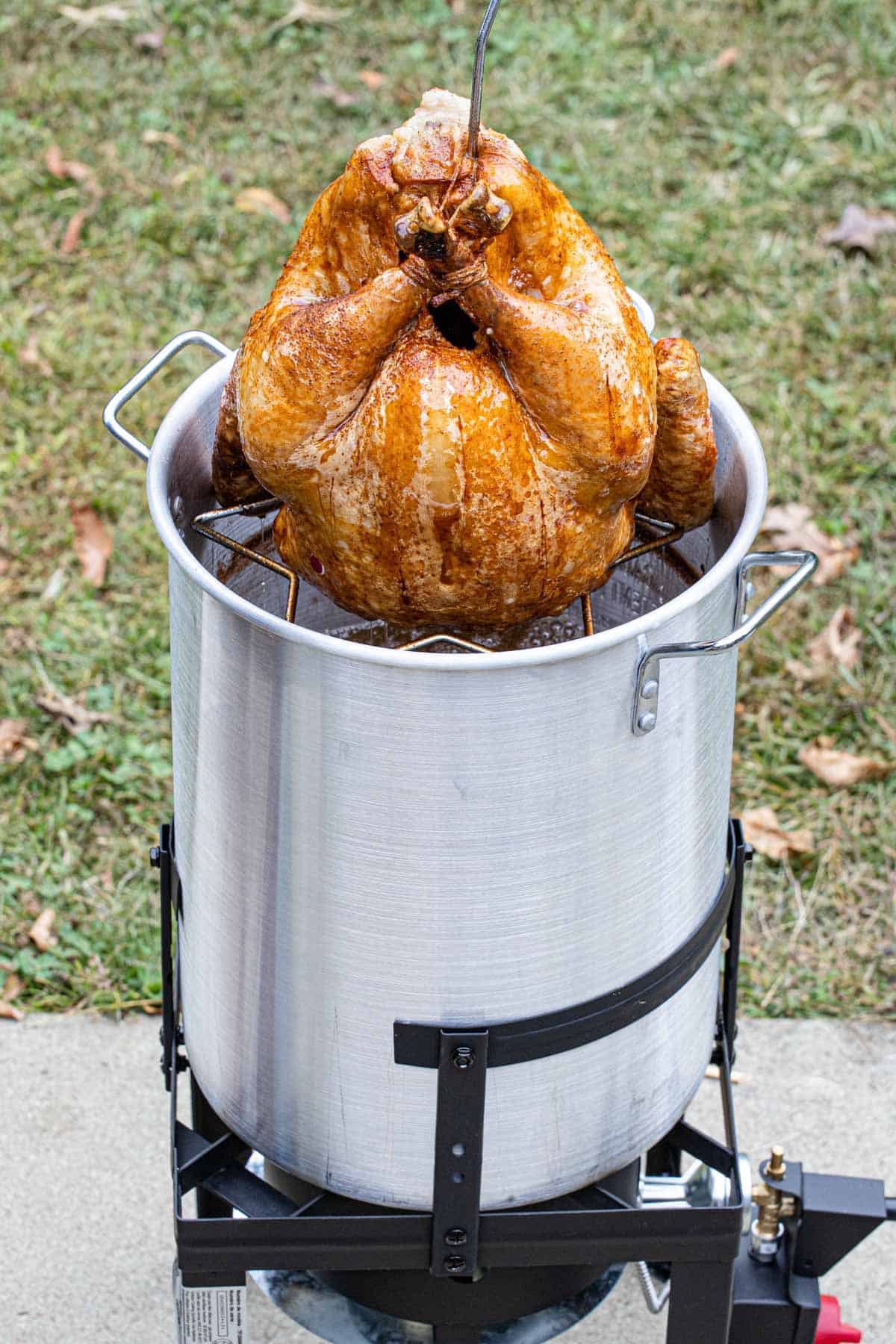
What to serve with Cajun fried turkey
- Classic Thanksgiving Sides: Pair up this fried turkey with a cozy dish of creamy mashed potatoes, that sweet and savory cornbread stuffing, tangy oyster dressing, or even a big ol’ scoop of green bean casserole.
- Sauce It Up: Take things to the next level with a side of homemade giblet gravy, turkey gravy, or a tangy cranberry sauce.
- Holiday Drink Pairings: Wash it all down with a festive glass of spiced apple cider, a Thanksgiving punch, or a Christmas punch.
- Finish With Dessert: End the feast with a slice of pumpkin pie, apple pie, a gooey pecan pie, or a generous helping of sweet potato casserole.
Recipe Substitutions
- Swap Out Butter: If you’re dairy-free, use a high-smoke-point oil like avocado oil instead of butter for the injection.
- Herbs and Spices: Add some fresh thyme, rosemary, or a little smoked paprika to your turkey injection for an extra layer of flavor.
- Seasoning Blends: If Cajun isn’t your thing, try a homemade turkey rub, BBQ rub, lemon-pepper seasoning, or even a classic herbes de Provence.
- Oil Choices: Canola or sunflower oil also work well, though they might slightly alter the flavor.
Recipe Variations and Additions
- Spice Level: Adjust the heat by playing with the amount of Cajun seasoning or cayenne pepper. Some like their Cajun fried turkey hot, some not!
- Sweet and Tangy: A small amount of maple syrup or honey in the injection can balance out the spices with some sweetness.
- Fruit Juices: Try adding apple or orange juice to the injection. It pairs surprisingly well with the Cajun spices!
- Garlic Lovers: Double up on the garlic powder or toss a few smashed garlic cloves right into the marinade pot. The more garlic, the better!

Expert Tips and Tricks for making the best fried turkey recipe
- Quality Turkey: Start with a quality bird, y’all. The better the turkey, the better the end result. Make sure it’s fully thawed and at room temp before you start the process.
- Injection Timing: Inject the marinade at least a few hours before frying to let those flavors permeate the meat. If you can do it up to 24 hours ahead, even better!
- Dry it Well: Thoroughly pat dry the turkey inside and out before frying. Any extra moisture can cause that oil to act up, and we don’t want any splattering now, do we?
- Temperature Check: Monitor your oil temperature closely. Maintaining a consistent temp between 350°F and 375°F is key for a crispy exterior and juicy interior.
How to store & reheat Fried Turkey
If you’ve got leftovers (and that’s a big if, ’cause this turkey is just that good), wrap ’em tightly in aluminum foil or plastic wrap. Place them in an airtight container and keep in the fridge.
Whether it’s from the fridge or the freezer, you’ll want to reheat your turkey without drying it out. To do this, preheat your oven to 325°F. Place the turkey in an oven-safe dish and cover it with aluminum foil to keep it moist. Heat until the internal temperature reaches 165°F. If it’s from the freezer, thaw in the fridge overnight before reheating.
How long will Fried Turkey last in the fridge?
In the fridge, your fried turkey will stay good for about 3 to 4 days. So, if you’re anything like me, you’ll be munchin’ on leftovers until you’re ready to gobble no more!
Can I freeze Cajun fried turkey?
You can freeze this bird. Just make sure to remove the meat from the bones first. Wrap the turkey slices or pieces in aluminum foil and then put them into a freezer-safe plastic bag. Squeeze out as much air as you can before sealing. Your turkey will keep for up to 2-3 months in the freezer.
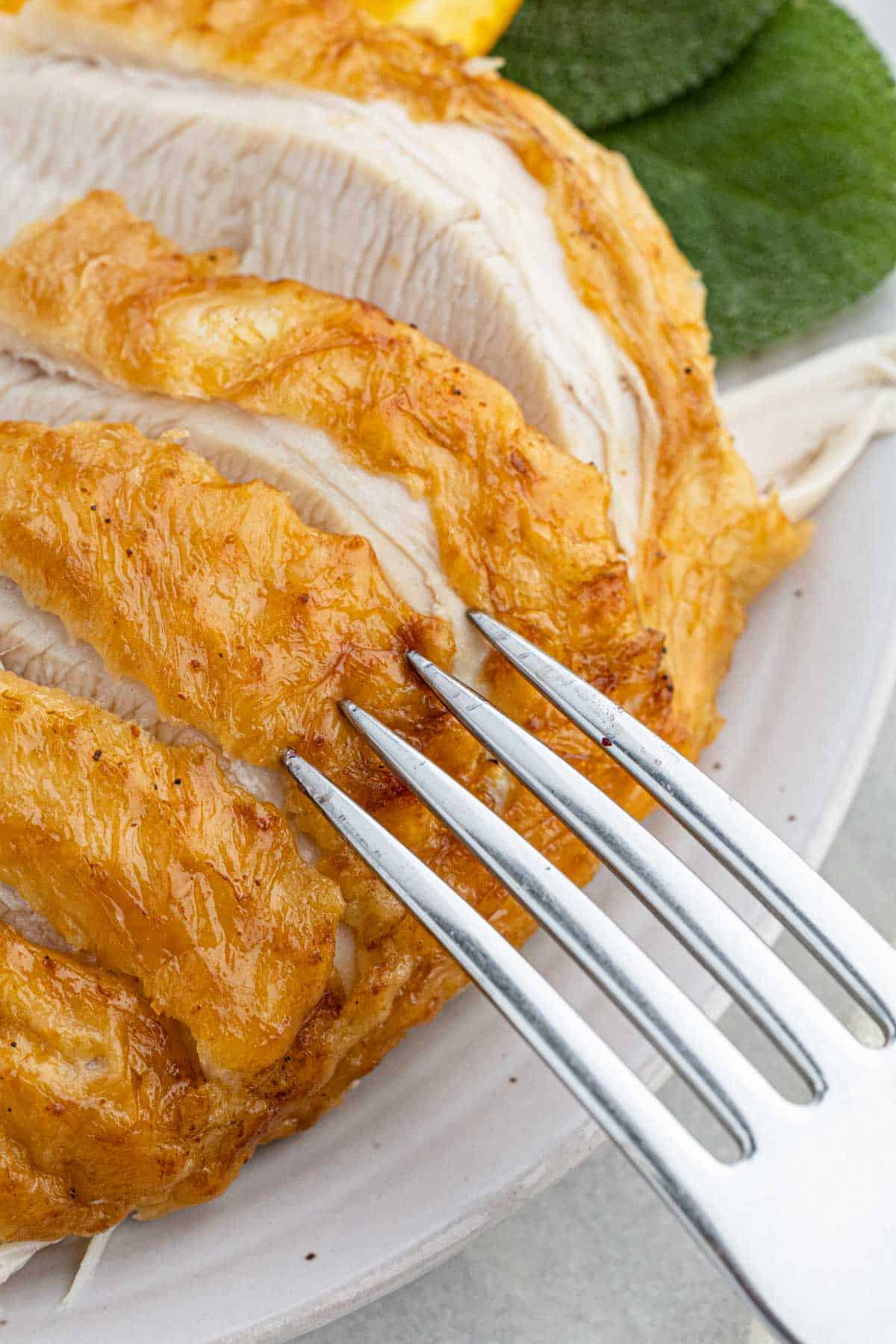
Frequently asked questions
I would suggest staying under a 15-pound turkey in fryers that claim an 18-pound maximum. Most indoor and outdoor fryers boast about being able to handle up to an 18-pound turkey but I wouldn’t recommend going THAT hard. Smaller birds cook more evenly, and frying a large one increases the risk of burning the skin before the center cooks through. Large birds can also cause oil-spillover, even if you’ve properly measured the oil and have it below the maximum fill-line on the pot.
YES! Placing a wet or icy turkey in hot oil could land you in the hospital, especially if there are chunks of ice. As a general rule, turkey-thawing time in the fridge requires about 24 hours for every 5 pounds ( in a refrigerator set to about 40 degrees). Pay extra attention to this: a seemingly full defrosted turkey might still be hiding ice in its cavity, especially between the rib bones. Double, triple and quadruple-check that there is no ice hidden in there, and dry the bird well before putting it in the hot oil.
You don’t have to, but trust me, it’s worth it! Injecting adds flavor deep into the meat and keeps it juicy. For this recipe, I used my daddy’s signature homemade injection. It’s salty, sweet, spicy and well-balanced. After about 10 years of successful testing, I can confidently guarantee that this injection is IT!
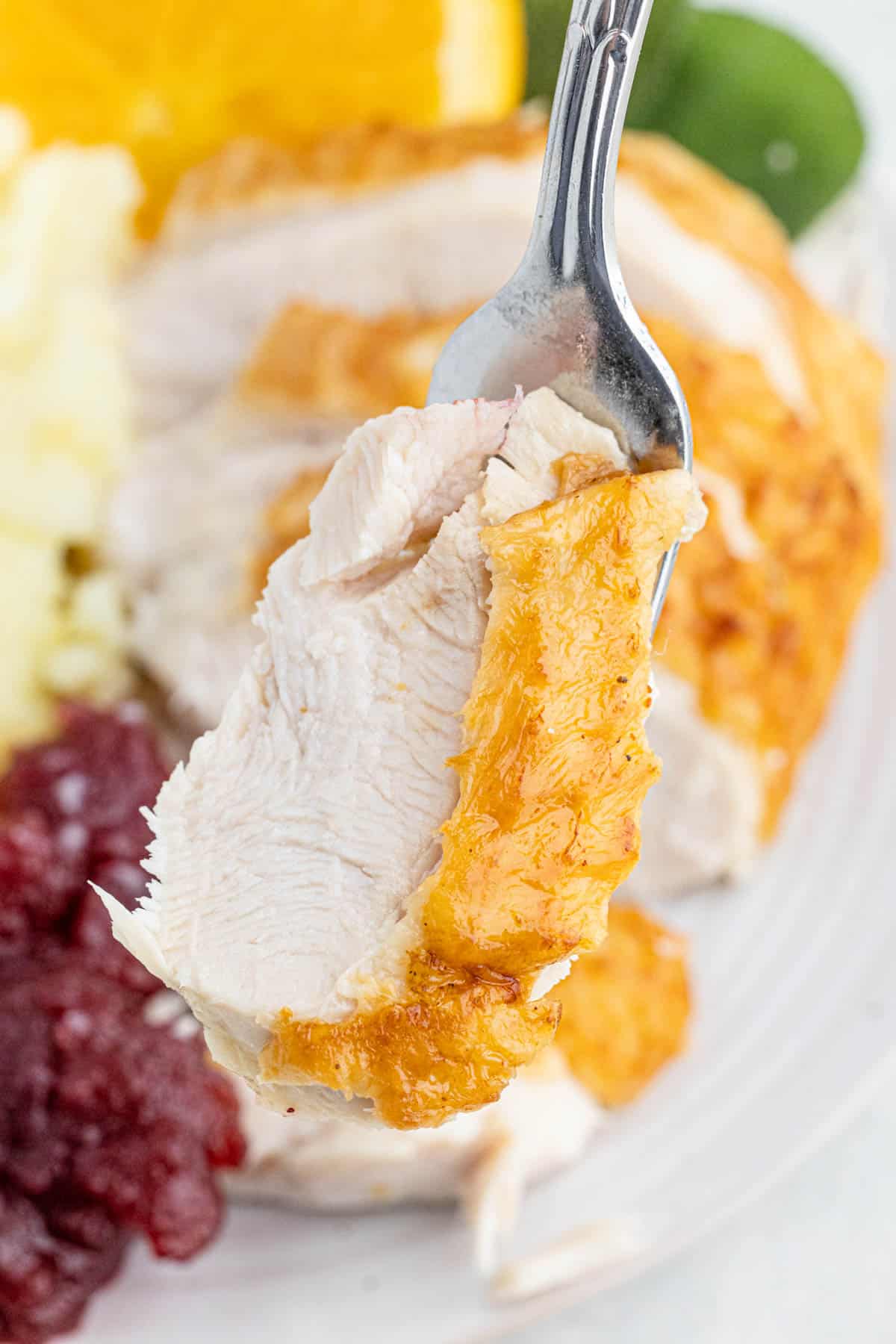
Beware: if you’ve never had a fried turkey, you might never want an oven-roasted one ever again. Fried Turkeys can deliver an incredibly-juicy bird with the crispiest skin possible. Seriously, I’m talking about a potato chip outside with a tender, fall-apart inside! So go ahead, prep your frying station, and get into it boos!
More Turkey Recipes
- Roasted Turkey Legs
- Turkey Pot Pie
- Turkey and Dumplings
- Turkey Chops
- Smothered Turkey Wings Recipe
- Baked Turkey Wings
- Turkey Empanada Recipe
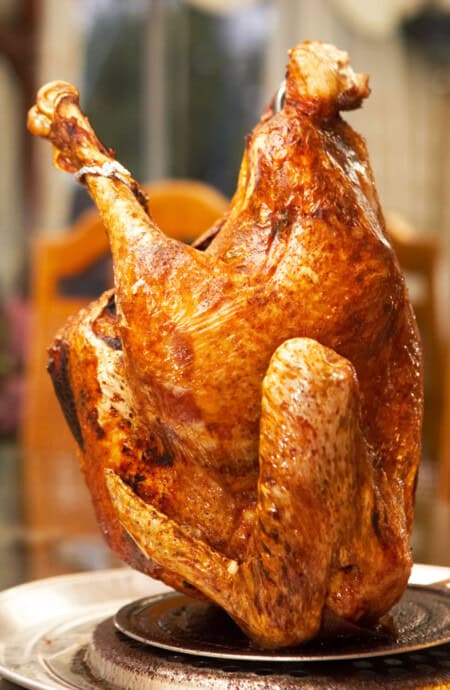
Fried Turkey
Want to Save This Recipe, Boo?
Equipment
Ingredients
For the Injection
- 1 cup chicken stock
- 1/3 cup salted butter melted
- 1/2 cup avocado oil
- 4 tbsp light brown sugar packed
- 4 tbsp worcestershire sauce
- 2 tbsp apple cider vinegar
- 2 tbsp onion powder
- 2 tbsp garlic powder
- 2 tbsp lemon juice
- 1 tbsp concentrated liquid crab boil
- 1 tbsp soy sauce
- 2 tsp seasoned salt
- 1 tsp cajun seasoning
- 1/4 tsp cayenne pepper
For the Turkey
- 1 turkey 10-14 lb, room temperature
- 3-5 gallons peanut oil
- cajun seasoning- can be store bought or turkey spice
Instructions
For the Injection
- Add all ingredients to a small pot over medium heat and simmer for 30 minutes until slightly reduced.
- Allow injection to come to room temperature and add to a injector.
For the Turkey
- Clean the turkey thoroughly inside and out.
- Once the turkey is completely thawed out and room temperature, place injection needle all over turkey particularly in meaty areas like breasts and thighs and inject liquid inside of turkey. If some comes out, just rub on the outside. (2-3 injections per thigh and 3-4 per breast should be good but the more the merrier if you want more flavor). Allow marinade to sit up to 24 hours.
- The longer the better! If you marinade overnight, keep in the fridge but then remove and let it come to room temp before you fry it. No cold turkey going in the oil y'all.
- Thoroughly sprinkle the turkey with cajun seasoning and rub in.
For Frying the Turkey
- Heat oil in a very large stockpot to 350 degrees. Once heat reaches temperature, insert hanger into turkey. It should be very secure.
- Slowly and carefully lower turkey into oil until fully submerged. Fry turkey about 3 minutes per pound but start checking sooner just in case.
- Turkey should reach an internal temperature of 165-170 degrees for white meat and 175-180 degrees for dark meat so when you check with your thermometer it should reach this temp.
- Once there, remove and allow to rest for at least 20-25 minutes.
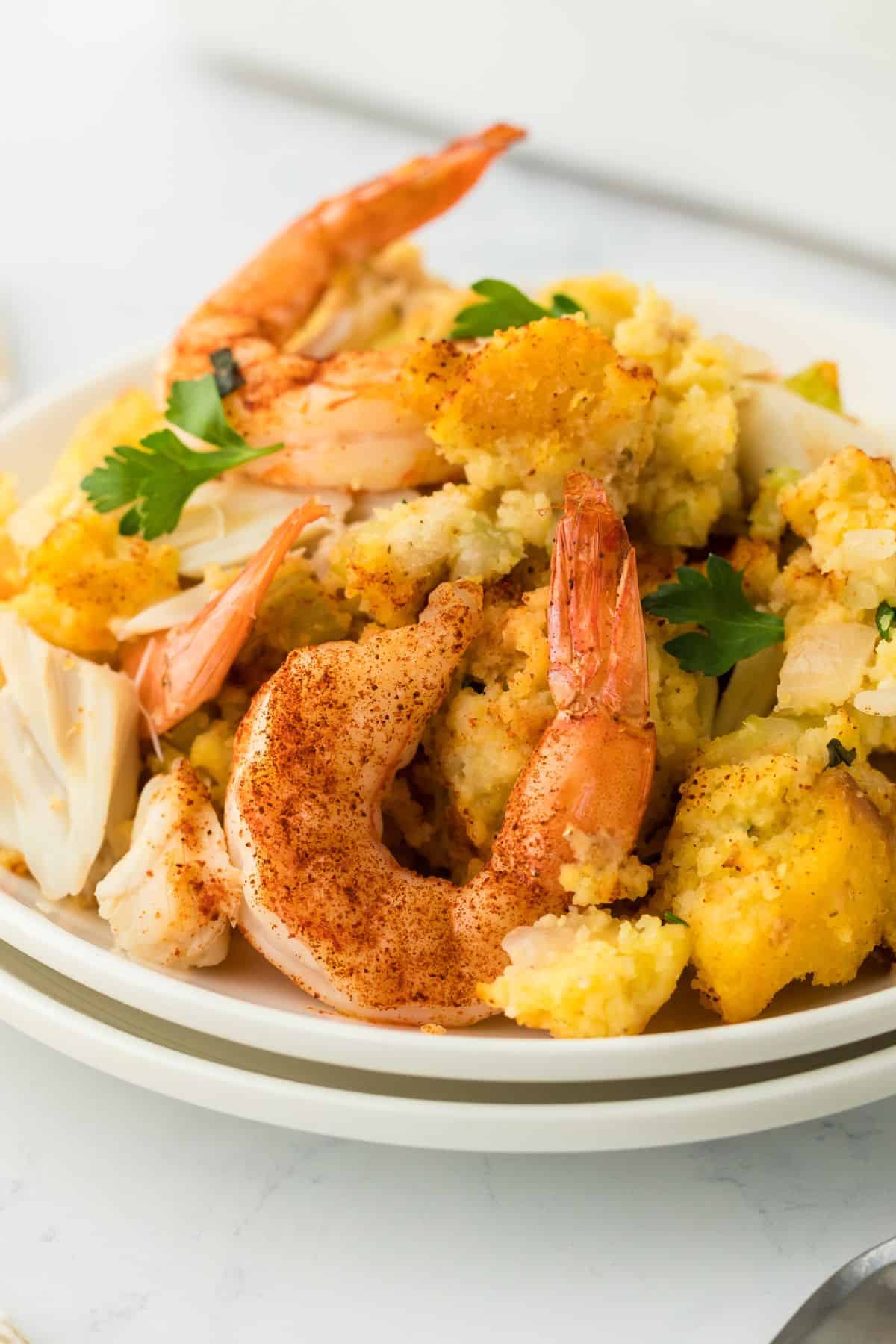
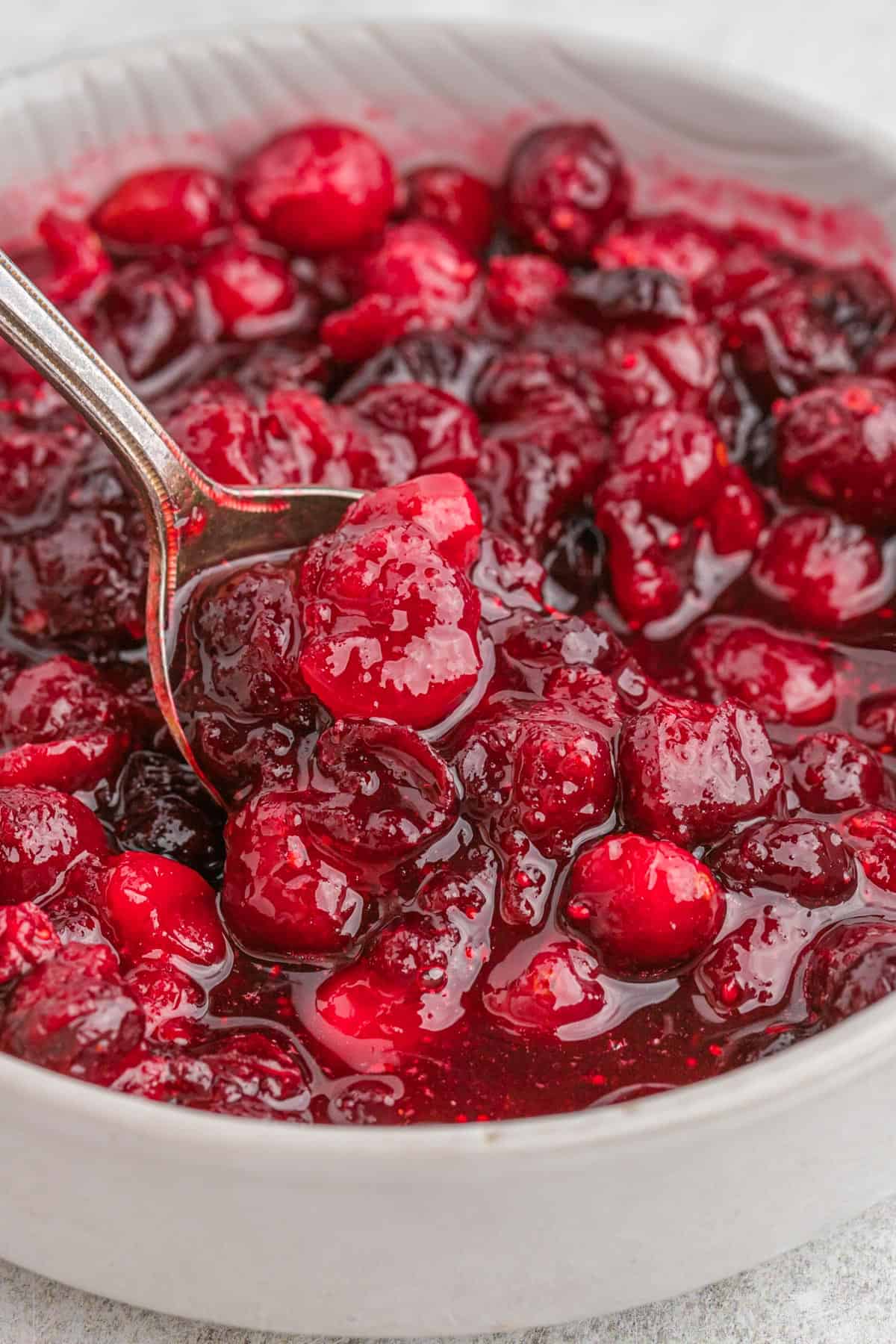
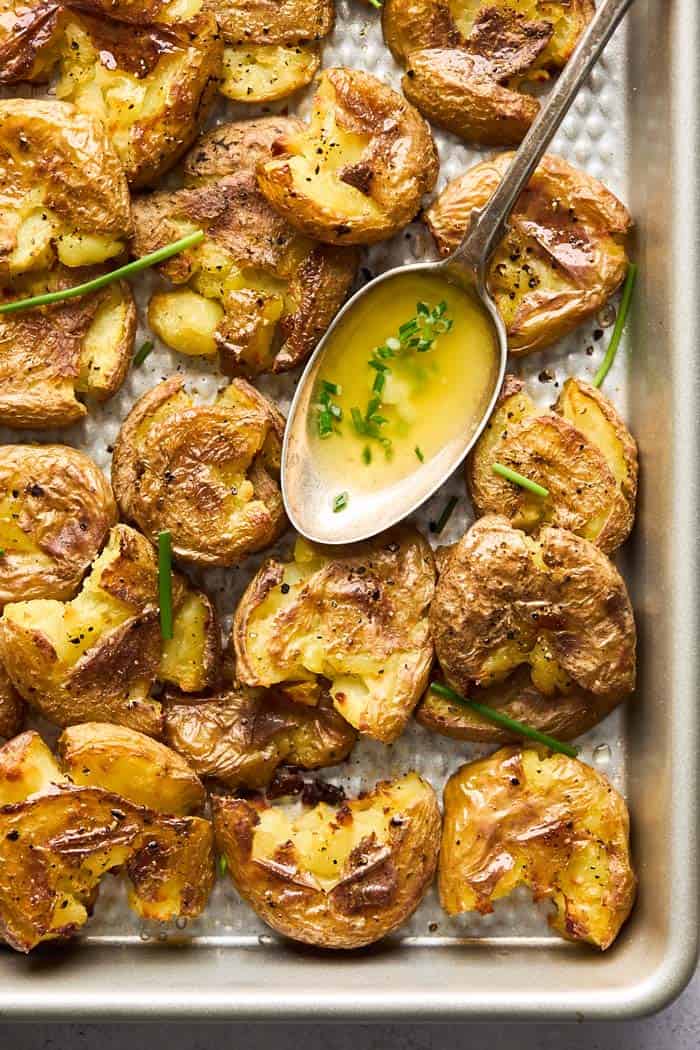
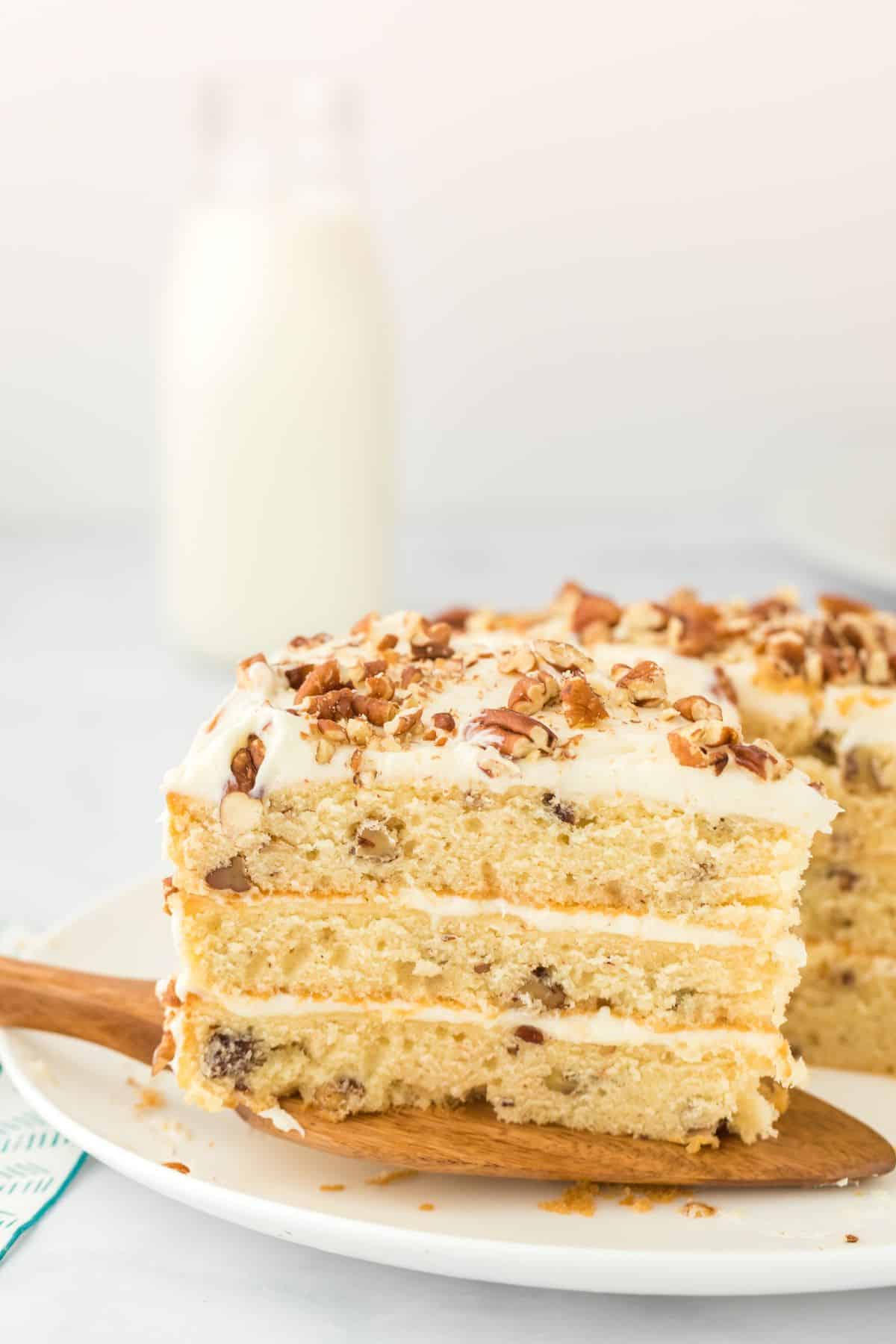
It sounds fantastic! Just be sure to use gluten free soy sauce if you have a gluten sensitivity / celiac disease. Regular soy sauce has wheat in it.
my concern is securing the legs, is it safe to tie them using twine??
I suggest not adding the twine so the legs can evenly cook
Isn’t it dangerous to inject a turkey with liquid and then deep fry it? Couldn’t that cause a fire ?
Nope there are literally liquid injections on the market for fried turkeys. This is a homemade one.
Do you brine before of just the injection and the rub? This will be our first time deep frying the turkey 🙂
No need to brine this one since the injection adds flavor into the whole thing.
Once injected do you allow it to sit for 24 hours in fridge? Then let it come to room temp again before frying?
Yes exactly. Don’t fry your turkey cold.
Can I add creole butter Mirande with it with out being to salty or don’t need it.
you can definitely add it but maybe taste for flavor before injecting to make sure you have to your liking.
I love how it turned out! This recipe is seriously amazing! Thanks for sharing!
I followed this recipe last year and put it in my favorites to pull up every Thanksgiving. It was so incredible and deserves 5 stars for sure. I’ll be serving it up again in a few weeks!
Never have I even considered frying this big, but after reading your post, I am inspired. Your turkey looks absolutely incredible – I bet it tastes better than roasted.